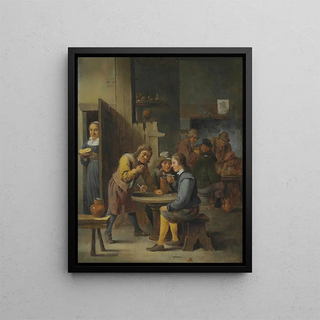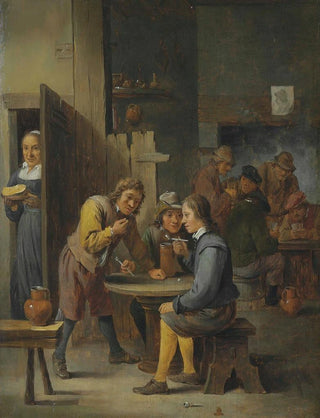Art print | Characters inside a tavern - David Teniers the Younger


View from behind

Frame (optional)
The scene painted by David Teniers the Younger, titled "Characters inside a tavern," transports us to the heart of a vibrant and lively atmosphere, typical of 17th-century Flemish taverns. This artwork, a true tableau of daily life, offers a fascinating glimpse into human interactions and the customs of the time. Teniers, with his keen eye and mastery of detail, manages to capture not only the characters but also the ambiance that prevails in this convivial space. The piece is an invitation to explore the subtleties of social life, where laughter, intoxication, and camaraderie blend in a warm setting. Through this art print, the viewer is immersed in a universe where each face tells a story, and every gesture evokes an emotion.
Style and uniqueness of the work
Teniers' style, recognized for its ability to combine precision and expressiveness, is fully expressed in this artwork. The characters, depicted with incredible liveliness, are endowed with distinct traits that reveal their personality and state of mind. The play of light and shadow creates an intimate atmosphere, while the warm color palette evokes the conviviality of the place. Teniers excels in representing textures, whether it is the raw wood of the tables, the clothing of the guests, or the sparkling drink in the mugs. Every element of the composition is carefully arranged, creating a dynamic that draws the eye and invites close observation. The scene is both a snapshot of daily life and a reflection on human nature, where joy and melancholy coexist in the same space.
The artist and his influence
David Teniers the Younger, son of the famous painter David Teniers the Elder, managed to forge his own artistic identity while remaining within the Flemish tradition. Active in the 17th century, he was a privileged witness to the social and cultural changes of his time, which is reflected in his work. Teniers captured the essence of popular life, going beyond noble subjects often favored by his contemporaries.

Matte finish

View from behind

Frame (optional)
The scene painted by David Teniers the Younger, titled "Characters inside a tavern," transports us to the heart of a vibrant and lively atmosphere, typical of 17th-century Flemish taverns. This artwork, a true tableau of daily life, offers a fascinating glimpse into human interactions and the customs of the time. Teniers, with his keen eye and mastery of detail, manages to capture not only the characters but also the ambiance that prevails in this convivial space. The piece is an invitation to explore the subtleties of social life, where laughter, intoxication, and camaraderie blend in a warm setting. Through this art print, the viewer is immersed in a universe where each face tells a story, and every gesture evokes an emotion.
Style and uniqueness of the work
Teniers' style, recognized for its ability to combine precision and expressiveness, is fully expressed in this artwork. The characters, depicted with incredible liveliness, are endowed with distinct traits that reveal their personality and state of mind. The play of light and shadow creates an intimate atmosphere, while the warm color palette evokes the conviviality of the place. Teniers excels in representing textures, whether it is the raw wood of the tables, the clothing of the guests, or the sparkling drink in the mugs. Every element of the composition is carefully arranged, creating a dynamic that draws the eye and invites close observation. The scene is both a snapshot of daily life and a reflection on human nature, where joy and melancholy coexist in the same space.
The artist and his influence
David Teniers the Younger, son of the famous painter David Teniers the Elder, managed to forge his own artistic identity while remaining within the Flemish tradition. Active in the 17th century, he was a privileged witness to the social and cultural changes of his time, which is reflected in his work. Teniers captured the essence of popular life, going beyond noble subjects often favored by his contemporaries.






